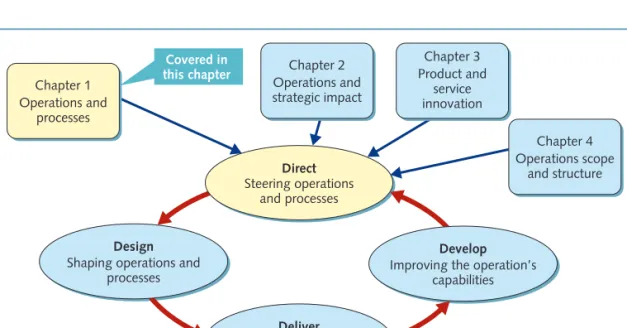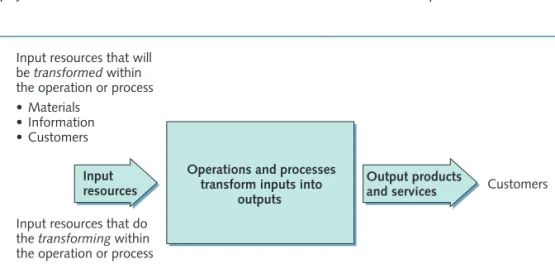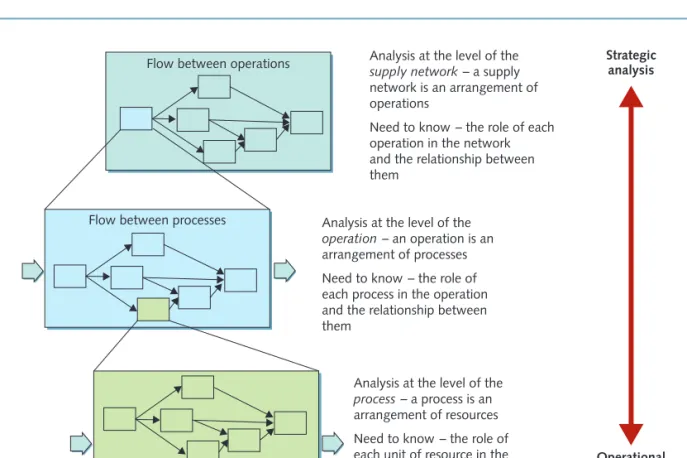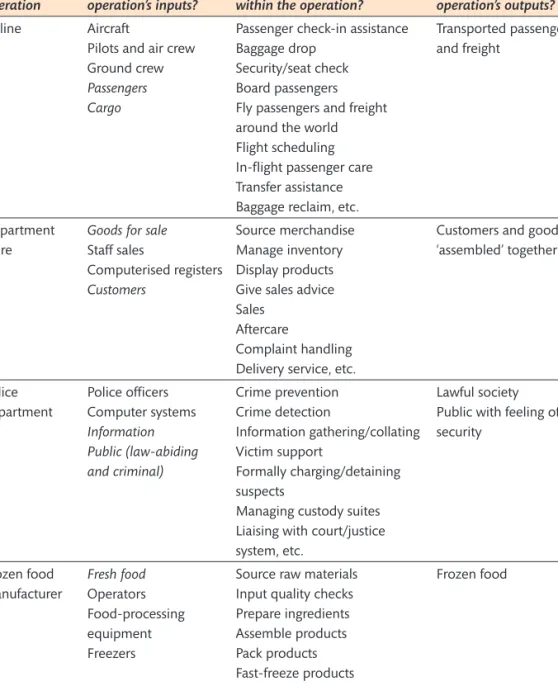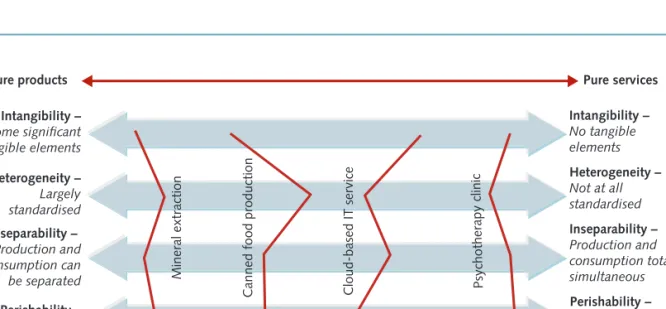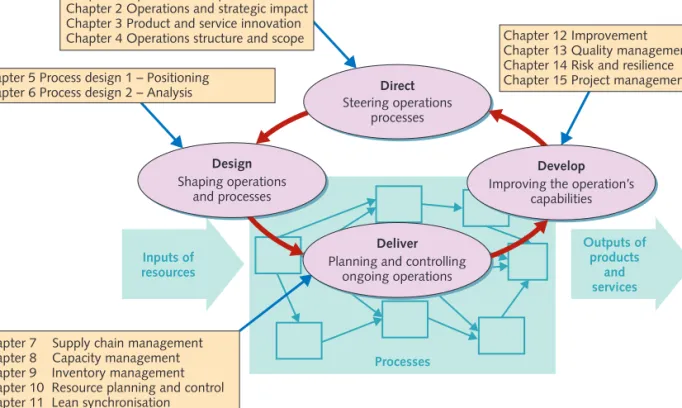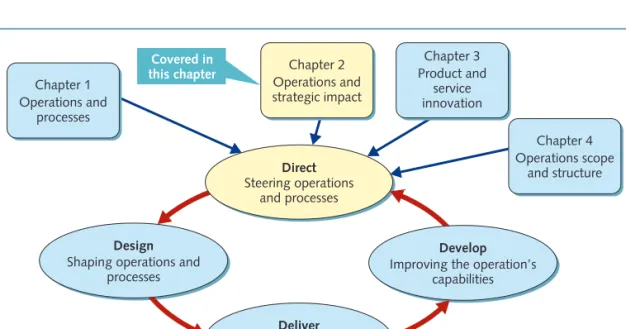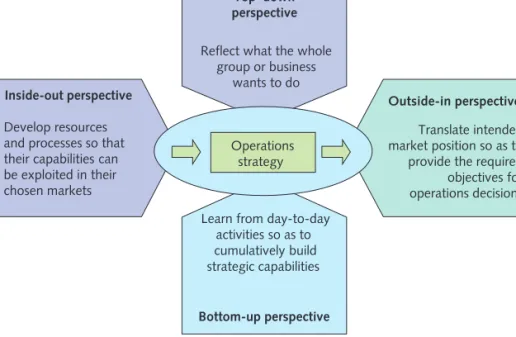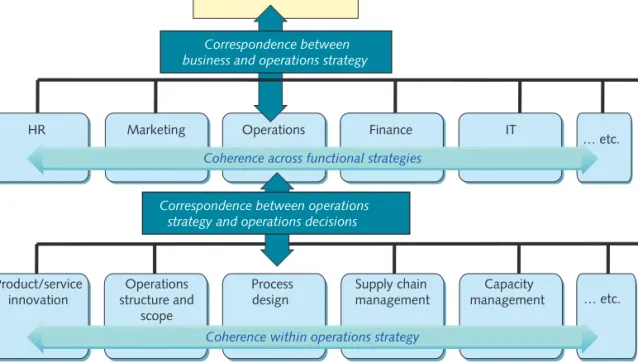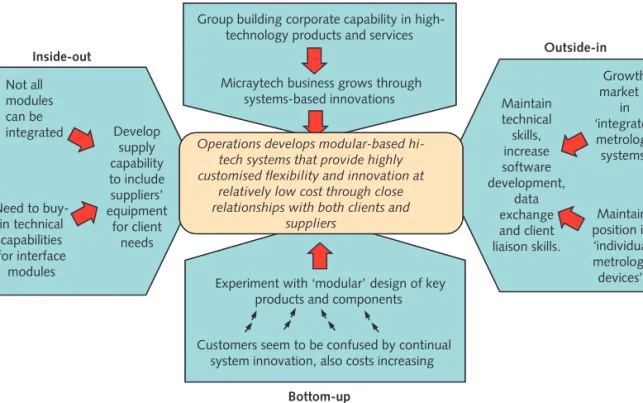OPERATIONS AND
PROCESS MANAGEMENT
make more of their lives through learning.
We combine innovative learning technology with trusted content and educational expertise to provide engaging
and effective learning experiences that serve people wherever and whenever they are learning.
From classroom to boardroom, our curriculum materials, digital learning tools and testing programmes help to educate millions of people worldwide – more than any other private enterprise.
Every day our work helps learning flourish, and wherever learning flourishes, so do people.
To learn more, please visit us at www.pearson.com/uk
OPERATIONS AND
PROCESS MANAGEMENT
Principles and Practice for Strategic Impact
Sixth Edition
Nigel Slack
Alistair Brandon-Jones
Harlow, England • London • New York • Boston • San Francisco • Toronto • Sydney • Dubai • Singapore • Hong Kong
KAO Park Harlow CM17 9NA United Kingdom Tel: +44 (0)1279 623623 Web: www.pearson.com/uk
First published 2006 (print)
Second edition published 2009 (print)
Third edition published 2012 (print and electronic) Fourth edition published 2015 (print and electronic) Fifth edition published 2018 (print and electronic) Sixth edition published 2021 (print and electronic)
© Pearson Education Limited 2006, 2009 (print)
© Pearson Education Limited 2012, 2015, 2018, 2021 (print and electronic)
The rights of Nigel Slack and Alistair Brandon-Jones to be identified as authors of this work has been asserted by them in accordance with the Copyright, Designs and Patents Act 1988.
The print publication is protected by copyright. Prior to any prohibited reproduction, storage in a retrieval system, distribution or transmission in any form or by any means, electronic, mechanical, recording or otherwise, permission should be obtained from the publisher or, where applicable, a licence permitting restricted copying in the United Kingdom should be obtained from the Copyright Licensing Agency Ltd, Barnard’s Inn, 86 Fetter Lane, London EC4A 1EN.
The ePublication is protected by copyright and must not be copied, reproduced, transferred, distributed, leased, licensed or publicly performed or used in any way except as specifically permitted in writing by the publishers, as allowed under the terms and conditions under which it was purchased, or as strictly permitted by applicable copyright law. Any unauthorised distribution or use of this text may be a direct infringement of the authors’ and the publisher’s rights and those responsible may be liable in law accordingly.
All trademarks used herein are the property of their respective owners. The use of any trademark in this text does not vest in the author or publisher any trademark ownership rights in such trademarks, nor does the use of such trademarks imply any affiliation with or endorsement of this book by such owners.
Pearson Education is not responsible for the content of third-party internet sites.
ISBN: 978-1-292-35006-6 (print) 978-1-292-35010-3 (PDF) 978-1-292-35011-0 (ePub)
British Library Cataloguing-in-Publication Data
A catalogue record for the print edition is available from the British Library
Library of Congress Cataloging-in-Publication Data Names: Slack, Nigel, author. | Brandon-Jones, Alistair, author.
Title: Operations and process management : principles and practice for strategic impact / Nigel Slack, Alistair Brandon-Jones.
Description: Sixth edition. | Harlow, England ; London ; New York : Pearson, 2021. | Includes bibliographical references and index. | Description based on print version record and CIP data provided by publisher; resource not viewed.
Identifiers: LCCN 2020055631 (print) | LCCN 2020055632 (ebook) | ISBN 9781292350103 (PDF) | ISBN 9781292350110 (ePub) | ISBN 9781292350066 (print)
Subjects: LCSH: Manufacturing processes. | Process control. | Operations research.
Classification: LCC TS183 (ebook) | LCC TS183 .O64 2021 (print) | DDC 658.5–dc23
LC record available at https://lccn.loc.gov/2020055631 LC record available at https://lccn.loc.gov/2020055632 10 9 8 7 6 5 4 3 2 1
25 24 23 22 21
Front cover image: Jackal Pan/Moment/Getty Images Cover design by Design Deluxe
Print edition typeset in Syntax Com of 9.25/12.5 pt Regular by SPi Global Printed in Slovakia by Neografia
Guide to case studies xv
Preface xvii
About the authors xxi
Author’s acknowledgements xxii
1 Operations and processes 1
2 Operations and strategic impact 41
3 Product and service innovation 81
4 Operations scope and structure 117
5 Process design 1 – Positioning 161
6 Process design 2 – Analysis 191
7 Supply chain management 235
8 Capacity management 271
9 Inventory management 307
10 Resource planning and control 339
11 Lean synchronisation 381
12 Improvement 415
13 Quality management 455
14 Risk and resilience 497
15 Project management 529
Index 565
Credits 577
Brief contents
Contents
Guide to case studies xv
Preface xvii
About the authors xxi
Author’s acknowledgements xxii
1 Operations and processes 1
Executive summary 2
1.1 Does the organisation understand the potential of operations and
process management? 4
1.2 Does the organisation take a process perspective? 8 1.3 Does operations and process management have a strategic impact? 22 1.4 Are processes managed to re ect their operating circumstances 26 1.5 Is operations and process decision-making appropriate? 30
Critical commentary 33
Summary checklist 34
Case study: Kaston-Trenton Service (KTS) 35
Applying the principles 38
Notes on chapter 39
Taking it further 40
2 Operations and strategic impact 41
Executive summary 42
2.1 Does the operation have a strategy? 44
2.2 Does operations strategy re ect business strategy (top-down) 50
2.3 Does operations strategy align with market requirements (outside-in)? 54
2.4 Does operations strategy learn from operational experience (bottom-up)? 60
2.5 Does operations strategy develop the capability of its resources and
processes (inside-out)? 61
2.6 Are the four perspectives of operations strategy reconciled? 65 2.7 Does operations strategy set an improvement path? 68
Critical commentary 73
Summary checklist 73
Case study: IKEA looks to the future 75
Applying the principles 78
Notes on chapter 79
Taking it further 80
3 Product and service innovation 81
Executive summary 82
3.1 What is the strategic role of product and service innovation? 84 3.2 Are the product and service innovation process objectives specified 89 3.3 Is the product and service innovation process defined 92 3.4 Are the resources for developing product and service innovation
adequate? 99
3.5 Is the development of products and services and of the process that
created them simultaneous? 104
Critical commentary 108
Summary checklist 109
Case study: Widescale Studios and the Fierybryde development 110
Applying the principles 114
Notes on chapter 115
Taking it further 116
4 Operations scope and structure 117
Executive summary 118
4.1 Does the operation understand its place in its supply network? 120 4.2 How vertically integrated should the operation’s network be? 124 4.3 How do operations decide what to do in-house and what to outsource? 127 4.4 What configuration should a supply network have 131 4.5 How much capacity should operations plan to have? 136
4.6 Where should operations be located? 140
Critical commentary 143
Summary checklist 144
Contents
■
ix
Case study: Aarens Electronic 145
Applying the principles 147
Notes on chapter 148
Taking it further 148
Supplement: Forecasting – Does the operation have an idea
of future demand? 151
5 Process design 1 – Positioning 161
Executive summary 162
5.1 Does the operation understand the importance of how it positions its
process resources? 164
5.2 Do processes match volume–variety requirements? 164
5.3 Are process layouts appropriate? 172
5.4 Are process technologies appropriate? 179
5.5 Are job designs appropriate? 181
Critical commentary 185
Summary checklist 185
Case study: McPherson Charles Solicitors 186
Applying the principles 188
Notes on chapter 190
Taking it further 190
6 Process design 2 – Analysis 191
Executive summary 192
6.1 Is the importance of detailed process design understood? 194
6.2 Are process performance objectives clear? 198
6.3 How are processes currently designed? 202
6.4 Are process tasks and capacity configured appropriately 206
6.5 Is process variability recognised? 217
Critical commentary 220
Summary checklist 221
Case study: The Action Response Applications Processing
Unit (ARAPU) 222
Applying the principles 224
Notes on chapter 225
Taking it further 226
Supplement: Queuing analysis 227
7 Supply chain management 235
Executive summary 236
7.1 Is the nature of supply chain management understood? 238 7.2 What type of supply chain relationship should be adopted? 243 7.3 Has the sourcing configuration been determined 245 7.4 Has the approach to supplier selection and negotiation
been determined? 248
7.5 Are supply chains run effectively? 250
7.6 Are supply chain dynamics under control? 256
Critical commentary 262
Summary checklist 263
Case study: Big or small? EDF’s sourcing dilemma 264
Applying the principles 268
Notes on chapter 269
Taking it further 270
8 Capacity management 271
Executive summary 272
8.1 Is the importance of capacity management understood? 274 8.2 Have patterns of demand been understood and in uenced 277 8.3 Has the operation’s current capacity been determined? 281 8.4 Have strategies for managing the ‘supply side’ been considered? 287 8.5 Have the consequences of capacity management decisions
been considered? 291
Critical commentary 296
Summary checklist 297
Case study: FreshLunch 298
Applying the principles 303
Notes on chapter 304
Taking it further 305
9 Inventory management 307
Executive summary 308
9.1 Is the role of inventory understood? 310
9.2 Why should there be any inventory? 312
9.3 Is the right quantity being ordered? 318
9.4 Are inventory orders being placed at the right time? 325
Contents
■
xi
9.5 Is inventory being controlled effectively? 329
Critical commentary 333
Summary checklist 334
Case study: supplies4medics.com 335
Applying the principles 337
Notes on chapter 338
Taking it further 338
10 Resource planning and control 339
Executive summary 340
10.1 Does resource planning and control have all the right elements? 341 10.2 Is resource planning and control information integrated? 346 10.3 Are core planning and control activities effective? 351
Critical commentary 364
Summary checklist 365
Case study: Audall Auto Servicing 366
Applying the principles 370
Notes on chapter 372
Taking it further 373
Supplement: Materials requirements planning (MRP) 375
11 Lean synchronisation 381
Executive summary 382
11.1 What are the benefits of lean synchronisation 384 11.2 What are the barriers to lean synchronisation? 388
11.3 Is ow streamlined 394
11.4 Does supply exactly match demand? 398
11.5 Are processes exible 399
11.6 Is variability minimised? 400
11.7 Is lean synchronisation applied throughout the supply network? 403
Critical commentary 406
Summary checklist 408
Case study: St Bridget’s Hospital 409
Applying the principles 412
Notes on chapter 413
Taking it further 414
12 Improvement 415
Executive summary 416
12.1 Why is improvement so important? 418
12.2 What is the gap between current and required performance? 419 12.3 What is the most appropriate improvement path? 431 12.4 What techniques could be used to facilitate improvement? 438
12.5 How can improvement be made to stick? 442
Critical commentary 446
Summary checklist 447
Case study: Ferndale Sands Conference Centre 448
Applying the principles 451
Notes on chapter 453
Taking it further 454
13 Quality management 455
Executive summary 456
13.1 Is the importance of quality management universally understood and
applied? 458
13.2 Is quality adequately defined 462
13.3 Is quality adequately measured? 465
13.4 Is quality adequately controlled? 469
13.5 Does quality management always lead to improvement? 472
Critical commentary 475
Summary checklist 476
Case study: Rapposcience Labs 477
Applying the principles 481
Notes on chapter 483
Taking it further 483
Supplement: Statistical process control (SPC) 485
14 Risk and resilience 497
Executive summary 498
14.1 Is there an integrated approach to operations risk and resilience? 500
14.2 Have potential risks been assessed? 503
14.3 Have risk prevention measures been implemented? 511
14.4 Have risk mitigation measures been implemented? 516
14.5 Have risk recovery measures been implemented? 519
Contents
■
xiii
Critical commentary 521
Summary checklist 521
Case study: Slagelse Industrial Services 523
Applying the principles 525
Notes on chapter 526
Taking it further 527
15 Project management 529
Executive summary 530
15.1 Are the innate characteristics of the project understood? 532 15.2 Is the applicability of project management understood? 535 15.3 Are the project environment and project stakeholders understood? 539 15.4 Has the project been effectively defi ned 544 15.5 Has the project been adequately planned? 545 15.6 Is the project effectively controlled and learned from? 551
Critical commentary 555
Summary checklist 556
Case study: Kloud BV and Sakura Bank K.K. 558
Applying the principles 561
Notes on chapter 562
Taking it further 563
Index 565
Credits 577
Companion Website
For open-access student resources specifi cally written to compliment this textbook and support your learning please visit
go.pearson.com/uk/he/resources
Lecturer Resources
For password-protected online resources tailored to support use of this textbook in teaching please visit go.pearson.com/uk/he/resources
ON THE WEBSITE
Guide to case studies
Chapter Case name and
description
Region Manufac- turing/
service
Company size
Topics/techniques
a er era i ns an processes
Kaston-Trenton Service (KTS)
UK M S Medium Role of operations, process
objectives, types of operation and process
a er era i ns an strategic impact
IKEA looks to the future
World S Large Operations strategy,
operations objectives, strategic fit
a er r c an service innovation
Widescale Studios and the Fierybryde development
UK S Small Product development,
operations strategy, process performance
a er era i ns scope and structure
Aarens Electronic Europe S/M Medium Location, capacity, scope of operations
a er r cess esi n 1 – Positioning
McPherson Charles Solicitors
UK S Medium Process design, job design,
process technology, process resourcing
a er r cess esi n 2 – Analysis
The Action Response Applications Processing Unit (ARAPU)
Africa, Asia, UK
S Small Process design, process mapping, balancing, Little’s Law
a er c ain
management
Big or small? EDF’s sourcing dilemma
UK S M Large
(EDF); Small (local SMEs)
Sourcing strategy, supplier selection, supplier development
a er a aci management
FreshLunch UK S Small Demand forecasting and
capacity planning a er n en r
management
supplies4medics.com Europe S Medium Inventory management, Inventory information systems, ABC analysis a er es rce
planning and control
Audall Auto Servicing UK S Medium Planning and control, Gantt charts, activity monitoring, controlling activities a er ean
synchronisation
St Bridget’s Hospital Europe S Medium Improvement, quality, application of lean principles a er r e en Ferndale Sands
Conference Centre
Australia S Small Improvement, performance,
prioritisation a er a i
management
Rapposcience Labs Netherlands M Medium Improvement principles, statistical process control, process learning, operations capabilities
a er is an resilience
Slagelse Industrial Services
Denmark S M Large Risk, failure prevention, supplier selection, relationship management
a er r ec management
Kloud BV and Sakura Bank K.K.
Netherlands and Japan
S Small
(Kloud
Project planning (timing, costing, resourcing) and
Preface
Why is operations and process management essential?
Because making operations and processes better will make the whole organisation better.
Because operations and process management is about getting things done. Because without effective operations and processes there can be no long-term success for any organisation.
Because it is at the heart of what all organisations do; they create value through their produc- tive resources. Because it is the essential link that connects broad long-term strategy and day- to-day ongoing activities. This is why operations and process management has been changing.
It has always been exciting, and it has always been challenging, but now it has acquired a much more prominent profile. The current edition reflects this in a number of ways.
This text stresses the importance of operations and process management
Of course, it has always been important, but increasingly managers in all types of enterprise are accepting that operations management can make or break their businesses. Effective oper- ations management can keep costs down, enhance the potential to improve revenue, promote an appropriate allocation of capital resources and, most importantly, develop the capabilities that provide future competitive advantage.
This text stresses the real strategic impact of operations and process management
Operations are not always operational. The operations function also has a vital strategic dimen- sion, and operations management is now expected to play a part in shaping strategic direction, not just responding to it.
This text stresses that operations and process management matters to all sectors of the economy
At one time, operations management was seen as being most relevant to manufacturing and a few types of mass-service businesses. Now the lessons are seen applying to all types of enter- prise: all types of service and manufacturing, large or small organisations, public or private, for-profit or not-for-profit.
This text stresses that operations and process management is of interest to all managers
Perhaps most importantly, because operations management is accepted as being founded on the idea of managing process, and because managers in all functions of the business are now accepting that they spend much of their time managing processes, it is clear that, to some extent, all managers are operations managers. The principles and practice of operations man- agement are therefore relevant to every manager.
This text extends the scope of operations and process management
from other functions are to be included, operations management must also address itself to process management at a more generic level. Also, no operation can consider itself in isolation from its customers, suppliers, collaborators and competitors. It must see itself as part of the extended supply network. Operations management increasingly needs to work at all three levels of analysis – the individual process, the operation itself and the supply network.
All this has implications for the way operations management is studied, especially at post- experience and postgraduate levels, and the way operations management is practised. It has also very much shaped the way this text has been structured. In addition to covering all the im- portant topics that make the subject so powerful, it places particular emphasis on the following:
•
Principles – that is, the core ideas that describe how operations behave, how they can be managed and how they can be improved. These are not immutable laws or prescriptions that dictate how operations should be managed, nor are they descriptions that simply explain or categorise issues. But they are indications of important underlying ideas.•
Diagnosis – an approach that questions and explores the fundamental drivers of operations performance. Aims to uncover or ‘diagnose’ the underlying trade-offs that operations need to overcome, and the implications and consequences of the courses of action that could be taken.•
Practice – anyone with managerial experience, or who is approaching careers choices, under- stands the importance of developing practical knowledge and skills that can be applied in practice. This requires an approach, as well as frameworks and techniques, that can be adapted to take account of the complexity and ambiguity of operations, yet give guidance to identifying and implementing potential solutions.Who should use this text?
This text is intended to provide an introduction to operations and process management for everyone who wishes to understand the nature, principles and practice of the subject. It is aimed primarily at those who have some management experience (although no prior academic knowledge of the area is assumed), or who are about to embark on a career in management.
For example:
•
MBA students should find that its practical discussions of operations management activities enhance their own experience.•
Postgraduate students on other specialist masters degrees should find that it provides them with a well-grounded and, at times, critical approach to the subject.•
Executives should find its diagnostic structure helpful to provide an understandable route through the subject.What makes this text distinctive?
It has a clear structure
The text is structured on a model of operations management that distinguishes between activities that contribute to the direction, design, delivery and development of operations and processes.
Preface ■ xix
It is based on practical diagnostic logic
Every chapter follows a series of questions that forms a ‘diagnostic logic’ for the topic. These are the questions that anyone can ask to reveal the underlying state of their, or any other, opera- tions. The questions provide an aid to diagnosing where and how an operation can be improved.
It is illustrations-based
Operations management is a practical subject and cannot be taught satisfactorily in a purely theoretical manner. Because of this, each chapter starts with a real-life example of how the topic is treated in practice and provides additional examples in relation to specific issues within each chapter.
It identifies key operations principles
Whenever a core idea of operations and process management is described in the text, a brief
‘operations principle’ summary is included in the margin. This helps to distil those essential points of the topic.
It includes critical commentaries
Not everyone agrees about what is the best approach to the various topics and issues within the subject. This is why we have, at the end of each chapter, included a ‘critical commentary’.
These are alternative views to the one being expressed in the main flow of the text. They do not necessarily represent our view, but they are worth debating.
Each chapter includes summary checklists
Each chapter is summarised in the form of a list of checklist questions. These cover the essential ques- tions that anyone should ask if they wish to understand the way their own or any other operation works. More importantly, they can also act as prompts for operations and process improvement.
Each chapter finishes with a case study
Every chapter includes a case study, relating real or realistic situations that require analysis, decision, or both. The cases have sufficient content to serve as the basis of case sessions in class, but are short enough to serve as illustrations for the less formal reader.
Each chapter includes an ‘applying the principles’ section
Selected problems, short exercises and activities are included at the end of each chapter. These provide an opportunity to test out your understanding of the principles covered in the chapter.
Each chapter includes a ‘taking it further’ section
A short annotated list of further reading and useful websites is provided, which take the topics in the chapter further, or treat some important related issues.
Suggested ‘model answers’ are available for all the ‘applying the principles’
exercises
Answers to the first two questions are available on the companion website for students.
Answers to all the questions are available to bone fide tutors and lecturers.
Instructor’s manual and PowerPoint slides
Visit go.pearson.com/uk/he/resources to find valuable online resources. A dedicated updated web-based instructor’s manual is available to lecturers adopting this text. It includes teaching notes for all chapters, guided solutions for all case studies in the text, guided solutions for active
About the authors
NIGEL SLACK is an Emeritus Professor of Operations Man- agement and Strategy at the University of Warwick, an Hon- orary Professor at the University of Bath and an Honorary fellow of the European Operations Management Associa- tion. Previously he has been Professor of Service Engineering at the University of Cambridge, Professor of Manufacturing Strategy at Brunel University London, a University Lectur- er in Management Studies at the University of Oxford and Fellow in Operations Management at Templeton College, Oxford. He worked initially as an industrial apprentice in the hand-tool industry and then as a production engineer and production manager in light engineering. He holds a Bachelor’s degree in Engineering and Master’s and Doctor’s degrees in Management, and is a Chartered Engineer. He is the author of many books in Operations Management, including The Operations Advantage, published in 2017, Operations Management (with Alistair Brandon-Jones), the ninth edition published in 2019, Operations Strategy (with Michael Lewis), the sixth edition published in 2020, The Manufacturing Advantage, published in 1991, Making Management Decisions (with Steve Cooke), published in 1991, Service Superiority (with Robert Johnston), published in 1993, The Blackwell Encyclopedic Dictionary of Opera- tions Management, published in 1997 and Perspectives in Operations Management (with Michael Lewis), published in 2003. Nigel has authored numerous academic papers and chapters in books. He also acts as a consultant to many international companies around the world in many sectors, especially financial services, transport, leisure and manufac- turing. His research is in the operations and manufacturing
exibility and operations strategy areas.
ALISTAIR BRANDON-JONES is a Full Chaired Professor in Operations and Supply Chain Management at the University of Bath, School of Management. He is also an Adjunct Professor for Hult International Business School and Danish Technical University. Since re-joining Bath in 2014, he has served as Associate Dean for Post- Experience
Education, responsible for MBA, EMBA and DBA programmes, and is currently Head of the Information, Decisions, and Operations Division (IDO). Previously, he was a Reader at Manchester Business School, Associate Professor and Assistant Professor at the University of Bath and a Teaching Fellow at Warwick Business School, where he also completed his PhD. His other books include Operations Management, the ninth edition published in 2019, Essentials of Operations Management, the second edition published in 2018 and Quantitative Analysis in Operations Management, published in 2008. Alistair is an active empirical researcher, focusing on digitisation in operations and supply networks, inter-organisational relationships and healthcare operations. His research has been published extensively in world-elite journals including Journal of Operations Management, International Journal of Operations and Production Management, International Journal of Production Economics and International Journal of Production Research. Alistair has led Operations Management, Operations Strategy, Supply Chain Management and Project Management courses at all levels and has been invited to teach at various international institutions, including the University of Cambridge, SDA Bocconi, Warwick Business School, NOVA University, Danish Technical University, Hult International Business School, Warwick Medical School and University College Dublin. His teaching has been recognised with a number of prizes for excellence and contributions to pedagogy, including from the Times Higher Education, Association of MBAs (AMBA), Production Operations Management Society (POMS), University of Bath, University of Manchester, University of Warwick and Hult International Business School. Alistair has consulting and executive development experience with organisations in various sectors, including petrochemicals, health, financial services, manufacturing, defence, govern- ment and non-profit. He is also a non-executive director for Brevio, a technology platform start-up aimed at improving grant processes for charities and grant makers.
In preparing this text, the authors, as usual, unashamedly exploited their friends and colleagues. In particular we had invaluable help from a great and distinguished reviewer team and from colleagues who have provided valuable feedback on various aspects of the project. For their help in case writing, we particularly thank: Vaggelis Giannikas, University of Bath, UK;
Jas Kalra, University College London, UK; Jens Roehrich, Uni- versity of Bath, UK; Nigel Spinks, Henley Business School, UK;
and Brian Squire, University of Bath, UK.
Colleagues at many universities have helped and contributed to our understanding of the subject, including: Malcolm Afferson, Sheffield Hallam University, UK; Pär Åhlström, Stockholm School of Economics, Sweden; David Bamford, University of Huddersfield, UK; Vikram Bhakoo, University of Melbourne, Australia; Mattia Bianchi, Stockholm School of Economics, Sweden; Umit Bitici, Strathclyde University, UK;
Briony Boydell, Portsmouth University, UK; Raffaella Cagliano, Politecnico di Milano, Italy; Dan Chicksand, Aston University, UK; Ben Clegg, Aston University, UK; Paul Coughlan, Trinity College Dublin, Ireland; Pamela Danese, University of Padova, Italy; Marc Day, Reading University, UK; Stephen Disney, Exeter University, UK; Des Doran, Kingston University, UK; Joy Field, Boton College, USA; Paul Forrester, Keele University, UK; Gino Franco, Derby University, UK; Abby Ghobadian, Reading University, UK; Janet Godsell, Warwick University, UK; Roger Hall, Huddersfield University, UK;
Ingjaldur Hannibalsson, University of Iceland, Iceland; Linda Hendry, Lancaster University, UK; Matthias Holweg, Oxford University, UK; Koos Krabbendam, University of Twente, The Netherlands; Bart MacCarthy, Nottingham University, UK;
John Maguire, Sunderland University, UK; Ian McCarthy, Simon Fraser University, Canada; Ronnie Mcmillan, University of Strathclyde, UK; Harvey Maylor, Cranfield University, UK;
Phil Morgan, Oxford Brookes University, UK; Andy Neely, Cambridge University, UK; Steve New, Oxford University, UK; Jan Olhager, Lund University, Sweden; Carie Queenan, University of South Carolina, USA; Zoe Radnor, City, University of London, UK; Pietro Romano, Udine University,
Italy; Sarah Schiffling, Lincoln University, UK; Mike Shulver, Bath University, UK; Alison Smart, University of Glasgow, UK;
Rui Sousa, Universidade Católica Portuguesa, Portugal; Martin Spring, Lancaster University, UK; Venu Venugopal, Nyenrode University, The Netherlands; Ann Vereecke, Vlerick Business School, Belgium; Rohit Verma, Cornell Univerity, USA; Jan de Vries, University of Groningen, The Netherlands; Graham Walder, Wolverhampton University, UK; Helen Walker, Cardiff University, UK; and Maggie Zeng, Kent University, UK.
Our very particular thanks go to our academic colleagues in the Operations Management Group at Warwick Business School, and Information, Decisions and Operations Division in Bath School of Management. They helped, both by contributing ideas and by creating a lively and stimulating work environment.
Our thanks to colleagues at Warwick go to: Vikki Abusid- ualghoul; Haley Beer; Nicola Burgess; Mehmet Chakkol; Max Finne; Emily Jamieson; Mark Johnson; Pietro Micheli; Giovanni Radaelli; Ross Ritchie; Rhian Silvestro; and Chris Voss.
Our thanks to colleagues at Bath go to: Meriem Bouazzaoui;
Teslim Bukoye; Melih Celik; Soheil Davari; Britt Davidson; David Ellis; Günes Erdogan; Emmanuel Fragniere; Vaggelis Giannikas;
Elvan Goklap; Andrew Graves; Joanne Hinds; Adam Joinson;
Richard Kamm; Gilbert Laporte; Michael Lewis; Sheik Meeran;
Meng Meng; Fotios Petropoulos; Lukasz Piwek; Jens Roehrich;
Ece Sanci; Gamila Shoib; Michael Shulver; Brian Squire; Oliver Thomasson; Christos Vasilakis; and Baris Yalabik.
Many practitioners also contributed, not least by keeping us honest to what really works in real operations. We thank and acknowledge: Vian Davys, CLP Holdings; David Garman, Deputy Chairman, John Menzies plc; Paul Gaskell, MD, The Value Engineers; and Tony Harpur, Ramblers Walking Holidays.
The prerequisite for any text of this type is that it serves a real market need. We were privileged to receive advice from the Pearson team; some of the most insightful people in busi- ness education publishing, in particular, Anita Atkinson, Felicity Baines and Rufus Curnow. Finally, to our families, Angela and Kathy, and Emma, Noah and George, your ongoing support is invaluable.
Author’s acknowledgements
Nigel Slack and Alistair Brandon-Jones
1 Operations and processes
Introduction
Operations management is about how organisations produce goods and services. Every product you use and every service you experience comes to you courtesy of the operations managers who organised its production. They may not always be called operations managers, but that is what they really are. They are the people who design, run and improve the processes that produce services and products for their customers. But operations and process management is even wider than this. After all, managers in other functions, such as marketing, sales and finance, also manage processes. They supply internal ‘customers’
with services such as marketing plans, sales forecasts, budgets, and so on. In fact, all parts of all organi- sations are made up of processes. That is why operations and process management is of direct relevance to all managers, irrespective of what type of organisation they work for, or which function they work in.
And that is what this text is about – the tasks, issues and decisions that are necessary to manage pro- cesses effectively, both within the operations function and in other parts of the business where effective process management is equally important. This first chapter is an introductory chapter, so we will exam- ine some of the basic principles of operations and process management. The model that is developed to explain the subject is shown in Figure 1.1.
Figure 1.1 Operations and process management is about how organisations produce goods and services Direct
Steering operations and processes
Develop Improving the operation’s
capabilities Design
Shaping operations and processes
Deliver Planning and controlling
ongoing operations
Chapter 4 Operations scope
and structure Chapter 2
Operations and strategic impact
Chapter 3 Product and
service innovation Chapter 1
Operations and processes
Covered in this chapter
1.1 Does the organisation understand the potential of operations and process management?
1.2 Does the organisation take a process perspective?
1.3 Does operations and process management have a strategic impact?
re r cesses ana e re ec eir era in circ s ances
1.5 Is operations and process decision-making appropriate?
Each chapter has a short executive summary structured around the number of diag- nostic questions used in the chapter. These diagnostic questions represent the basic line of enquiry that can reveal the nature and relevance of the topic covered in each chapter.
1.1 Does the organisation understand the potential of operations and process management?
The operations function is the part of the organisation that produces products or services. Every organisation has an operations function because every organisation produces some mixture of products and services. It is a central and important activity for any organisation. ‘Operations’ is not always called by that name, but whatever its name, it is always concerned with managing the core purpose of the business – serv- ing its customers by producing some mix of products and services. ‘Processes’ also produce products and services, but on a smaller scale. They are the component parts of operations. But other functions also have processes that need managing. In fact every part of any business is concerned with managing processes. All managers have something to learn from studying operations and process management, because the subject encompasses the management of all types of operation, no matter in what sector or industry, and all processes, no matter in which function.
1.2 Does the organisation take a process perspective?
A ‘process perspective’ means understanding businesses in terms of all their individual processes. It is only one way of modelling organisations, but it is a particularly useful one. Operations and process management uses the process perspective to analyse businesses at three levels: the operations function of the business; the higher and more strategic level of the supply network; and at a lower, more operational level of individual processes. Within the business, processes are only what they are defined as being. The boundaries of each process can be drawn as thought appropriate. Some- times this involves radically reshaping the way processes are organised, for example, to form end-to-end processes that fulfil customer needs.
EXECUTIVE SUMMARY
Executive summary
■
3
1.3 Does operations and process management have a strategic impact?
Operations and process management can make or break a business. When they are well managed, operations and processes can contribute to the strategic impact of the business in four ways: cost, revenue, investment and capabilities. Because the oper- ations function has responsibility for much of a business’s cost base, its first imper- ative is to keep costs under control. Additionally, it should be looking to enhance the business’s ability to generate revenue through the way it provides service and quality. Furthermore, all failures are ultimately process failures; well-designed pro- cesses should have less chance of failing and more chance of recovering quickly from failure. Also, because operations are often the source of much investment, it should be aiming to get the best possible return on that investment. Finally, the operations function should be laying down the capabilities that will form the long-term basis for future competitiveness.
1.4 Are processes managed to reflect their operating circumstances?
Not necessarily. Processes differ, particularly in what are known as the four Vs: vol- ume, variety, variation and visibility. High-volume processes can exploit economies of scale and be systematised. High-variety processes require enough inbuilt flexi- bility to cope with the wide variety of activities expected of them. High-variation processes must be able to change their output levels to cope with highly variable and/or unpredictable levels of demand. High-visibility processes add value while the customer is ‘present’ in some way and therefore must be able to manage custom- ers’ perceptions of their activities. Generally, high volume together with low variety, variation and visibility facilitate low-cost processes, while low volume together with high levels of variety, variation and visibility all increase process costs. Yet in spite of these differences, operations managers use a common set of decisions and activities to manage them. These activities can be clustered under four groupings: directing the overall strategy of the operation; designing the operation’s products, services and processes; planning and controlling process delivery; and developing process performance.
1.5 Is operations and process decision-making appropriate?
The range of operations decisions is wide and covers four broad areas that we cate- gorise as: ‘directing the overall strategy of the operation’; ‘designing the operation’s processes’; ‘planning and control process delivery’; and ‘developing process per- formance’. However, there are always overlaps and interrelationships between the categories. Yet, no matter what type of decision, operations managers use models (many of which are included in this text) to help them make decisions. Some mod- els are quantitative, some are qualitative, but in practice a blend of qualitative and quantitative is often the most useful approach. Remember, though, that all models are simplifications of a far more complex reality. Which is one reason for the interest in ‘behavioural operations management’, which attempts to incorporate real (usually non-rational) behaviour into operations decision-making.
1.1 Diagnostic question: Does the organisation understand the potential of operations and process management?
Operations and process management is the activity of managing the resources and processes that produce products and services, for internal and external customers. It is a central and important activity for any organisation. The core body of knowledge for the subject comes from
‘operations management’, which examines how the ‘operations function’ of an organisation produces products and services for external customers. In some organisations an operations manager could be called by some other name, for example, a ‘fleet manager’ in a logistics com- pany, an ‘administrative manager’ in a hospital or a ‘store manager’ in a supermarket. Note also that throughout this text the terms ‘the operation’, ‘the operations function’, and ‘operations’, will be used, more or less interchangeably. Also ‘the organisation’, ‘the business’, ‘the firm’ and
‘the enterprise’ are used to mean whatever formal body (public or private) one is working for.
All enterprises have ‘operations’
All organisations have ‘operations’, because all organisations produce products, services or some mixture of both. If you think that you don’t have an operations function, you are wrong.
If you think that your operations function is not important, you are also wrong. In most enter- prises the operations function represents the bulk of its assets and the majority of its people.
It is the means by which they serve their customers and provide an economic and/or social return for their stakeholders. An effective operations function has the potential to survive in a turbulent environment and the ability to maintain a steady improvement in its performance. By contrast, a poorly managed operations function, especially if it fails to provide adequate service to its customers or fails to provide the efficiency to work within its cost constraints, will always prevent an organisation from achieving its objectives, whether social or economic. But the sub- ject does have something of an image problem. It is sometimes seen as dealing with routine,
‘technical’, low-level activities that obviously have to be done – but preferably by someone else. Worthy maybe, and even challenging, but neither exciting nor of direct interest to anyone outside the operations function itself. Wrong. ‘Operations’ is how one makes things happen. It is how organisations release whatever expertise they have, in order to create value. It is through one’s operations that customers are served.
It is through operations that one uses resources to their best advantage. And it is through one’s operations that strategy is made into reality.
But not all operations are the same
Look at the six businesses illustrated in Figure 1.2. There are two financial service companies, two manufacturing companies and two hotels. All of them have operations functions that produce the things that their customers are willing to pay for. Hotels produce accommodation services; financial services invest, store, move or sell money and investment opportunities; and manufacturing businesses physically change the shape and the nature of materials to produce products. These businesses are from different sectors (banking, hospitality and manufacturing), but it is not that they operate in different sectors of the economy that makes these businesses different from each other. There are often bigger differences within economic sectors than between them. The main difference between how their operations activities need to be managed is more closely related to the market position that they occupy. So, for example, all three operations in the left-hand column provide value-for-money products and services and compete largely on cost.
The three in the right-hand column provide more ‘upmarket’ products and ser- vices that are more expensive to produce and compete on some combination OPERATIONS PRINCIPLE
All organisations have ‘operations’
that produce some mix of products and services.
OPERATIONS PRINCIPLE The economic sector of an operation is less important in determining how it should be managed than its intrinsic characteristics.
1.1 Diagnostic question: Does the organisation understand the potential of operations and process management?
■
5
of high specification and customisation. The implication of this is important. It means that the surface appearance of a business and its economic sector are less important to the way its oper- ations should be managed than the intrinsic characteristics of what it is trying to achieve, such as the volume of its output, the variety of the products and services it needs to produce and, above all, how it is trying to compete in its market.
From production to operations management
Figure 1.3 illustrates how the scope of this subject has expanded over time. Originally, opera- tions management was almost exclusively associated with the manufacturing sector. It would have been called ‘production’ or ‘manufacturing’ management. Starting in the 1970s and 1980s the term operations management was used to reflect two trends. First, and most importantly, it was used to imply that many of the ideas, approaches and techniques traditionally used in the manufacturing sector could be equally applicable in the (much larger) service sector. The second use of the term was to expand the scope of ‘production’ in manufacturing companies to include ‘non-core’, but important, production-related processes such as purchasing, physical Figure 1.2 All types of business have ‘operations’ because all businesses produce some mix of products and services.
And the differences in the operations within a category of business are often greater than the differences between business sectors
Financial services
An account management centre at a large retail bank
Financial analyst advising a client at an investment bank
Tetra Images/Brand X Pictures/ Getty Images FangXiaNuo/E+/Getty Images
Furniture manufacturing
Mass production of kitchen units
Craft production of reproduction
‘antique’ furniture
Albert Karimov/Alamy Stock Photo Alistair Berg/DigitalVision/ Getty Images
Hotels
Value-for-money hotel
Lobby of an international luxury hotel
Chubykin Arkady/Shutterstock Mint Images RF/Getty Images
From operations management to operations and process management . . .
More recently the term operations and process management (or sometimes just process man- agement) has been used to denote the shift in the scope of the subject to include the whole organisation. Within any business, the production of products and services is not confined to the operations function. After all, every part of any business achieves its objectives by organis- ing its resources such as people, information systems, buildings and equipment into individual
‘processes’. A ‘process’ is an arrangement of resources and activities that transform inputs into outputs that satisfy (internal or external) customer needs. For example, the marketing function
‘produces’ marketing plans and sales forecasts, the accounting function ‘produces’ budgets, the human resources function ‘produces’ development and recruitment plans, and so on. In fact every part of any business is concerned with managing processes.
The difference between operations and processes is one of scale, and therefore complex- ity. Both transform inputs into outputs (we shall look at this idea later), but processes are the smaller version. They are the component parts – the building blocks – of an operation. So,
‘operations and process management’ is the term we use to encompass the management of all Figure 1.3 The scope of operations management has expanded from focusing on processes in manufacturing organisations to include service organisations, processes in other functions (such as marketing, finance and HRM) and how operations interact with each other in supply networks and chains
From manufactured goods to all goods and services Physical
goods Goods and
services
Core operations
processes
All processes
Individual operations Networks of operations
From those processes that create products and services directly to all processes in all functions
From considering the internal processes of a single operation to considering how networks and chains of operations connect and relate to each other
Type of operation
Interaction between operations
Type of process
types of operation, no matter in what sector or industry, and all processes, no matter in which function of the business. The general truth is that processes are everywhere, and all types of managers have something to learn from studying operations and process management. This is very much how we treat the sub- ject in this text. That is why it is called Operations and Process Management:
it includes an examination of the operations function in both manufacturing and service sectors, as well as the management of processes in non-operations functions.
. . . and operations and supply management
The third big development in how the subject was viewed was the (almost) universal accept- ance that operations outside the conventional boundary of an enterprise would have an impor- tant effect on how it performed. The suppliers of goods and services to an operation could have as much impact on its activities as how it managed its internal resources and processes.
Moreover, the boundary of an enterprise is not fixed or immutable, it is determined by deci- sions made by the operation itself. For example, should an operation perform activities itself, or should it outsource the activity? No operation does everything itself; some degree of outsourc- ing is inevitable. Therefore, confining this subject to internal activities would clearly give only a partial picture. This is why we frequently refer to operations and process-based issues in the wider ‘supply network’ (we shall define this term later) and devote two chapters specifically to supply network issues (Chapters 4 and 7).
OPERATIONS PRINCIPLE All operations are composed of processes. A process is an arrangement of resources and activities that transform inputs into outputs that satisfy (internal or external) customer needs.
Case example
Torchbox: award-winning web designers
1There are around two billion websites in the world. So many that we usually take them for granted, yet browsing websites as part of our studies, our job or our leisure is an activity that we all do; probably every day, probably many times each day. It’s important. And, not surprisingly, there is a whole industry devoted to designing websites so that they have the right type of impact. In fact, taken over the years, web development has been one of the fastest-growing industries in the world. But it’s also a tough industry. Not every web design company thrives, or even survives beyond a couple of years. To succeed, web designers need technology skills, design capabilities, busi- ness awareness and operational professionalism. One that has succeeded is Torchbox, an independent web design and development company, with offices in Oxfordshire, Bristol and Cambridge in the UK. Founded back in 2000 by Tom Dyson and Olly Willans, on Employee Ownership Day 2019 they handed over the ownership of the com- pany to its employees, who elected a board of employee trustees to oversee the company’s work and who have ultimate control over the business.
It was a move that fitted their ethos of providing high-quality, cost-effective and ethical solutions for cli- ents who come primarily, but not exclusively, from the
charity, non-governmental organisations and public sec- tors. ‘There are a number of advantages about being a relatively small operation’, says co-founder and Technical Director Tom Dyson, who has been responsible for the technical direction of all major developments. ‘We can be hugely flexible and agile, in what is still a dynamic market.
But at the same time we have the resources and skills to pro- vide a creative and professional service. Any senior manager in a firm of our size cannot afford to be too specialised. All of us here have their own specific responsibilities; however, every one of us shares the overall responsibility for the firm’s general development. We can also be clear and focused on what type of work we want to do. Our ethos is important to us. We set out to work with clients who share our com- mitment to environmental sustainability and responsible, ethical business practice; we take our work, and that of our clients, seriously.’
Nevertheless, straightforward operational effective- ness is essential to Torchbox’s business. ‘We know how to make sure that our projects run not only on time and to budget’, says Olly Willans, the firm’s Creative Director, ‘but we also like to think that we provide an enjoyable and stim- ulating experience – both for our customers’ development teams and for our staff too. High standards of product and 1.1 Diagnostic question: Does the organisation understand the potential of operations and process management?
■
7
service are important to us: our clients want accessibility, usability, performance and security embedded in their web designs, and of course, they want things delivered on-time and on-budget. We are in a creative industry that depends on fast-moving technologies, but that doesn’t mean that we can’t also be efficient. We back everything we do with a robust feature-driven development process using a kan- ban project management methodology which helps us manage our obligations to our clients.’ Tom Dyson adds,
‘Using sound operations management techniques helps us constantly to deliver value to our clients. We like to think that our measured and controlled approach to handling and controlling work helps ensure that every hour we work
produces an hour’s worth of value for our clients and for us.’ Maskot/Getty Images
1.2 Diagnostic question: Does the organisation take a process perspective?
Central to making operations and process management a significant contributor to an enter- prise’s success is the idea of a ‘process perspective’. A process perspective means understanding that all parts of the business can be seen as processes, and that all processes can be managed using operations management principles. Yet, although important, a process perspective is not the only way of describing businesses, or any type of organisation. One could represent an organisation as a conventional ‘organisational structure’ that shows the reporting relationships between various departments or groups of resources. But even a little experience in any organ- isation shows that rarely, if ever, does this fully represent the way the organisation actually works. Alternatively, one could describe an organisation through the way it makes decisions:
how it balances conflicting criteria, weighs up risks, decides on actions and learns from its mis- takes. Or, one could describe an organisation by explaining its culture – its shared values, ideol- ogy, pattern of thinking and day-to-day rituals, or its power relationships – how it is governed, seeks consensus (or at least reconciliation), and so on. Or, and this is the significant point, one can represent the organisation as a collection of processes, interconnecting and (hopefully) all contributing to fulfilling its strategic aims. This is the perspective that we emphasise throughout this text. As we define it here, the process perspective analyses businesses as a collection of interrelated processes. Some of these processes will be within the operations function, and will contribute directly to the production of its products and services. Other processes will be in the other functions of the business, but will still need managing using similar principles to those within the operations function.
None of these various perspectives on organisations gives a total picture. Each perspective adds something to our ability to understand, and therefore more effectively manage a business.
Nor are these perspectives mutually exclusive. A process perspective does not preclude under- standing the influence of power relationships on how processes work, and so on. We use the process perspective here, not because it is the only useful and informative way of understand- ing businesses, but because it is the perspective that directly links the way we manage resources
in a business with its strategic impact. Without effective process management, the best strategic plan can never become reality. The most appealing promises made to clients or customers will never be fulfilled. In addition, the process perspective has traditionally been undervalued. The subject of operations and process management has only recently come to be seen as universally applica- OPERATIONS PRINCIPLE
There are many valid approaches to describing organisations.
The process perspective is a
1.2 Diagnostic question: Does the organisation take a process perspective?
■
9
Operations and process management is relevant to all parts of the business
If processes exist everywhere in the organisation, operations and process management will be a common responsibility of all managers, irrespective of which function they are in. Each function will have its ‘technical’ knowledge, of course. In marketing, this includes the market expertise needed for designing and shaping marketing plans; in finance, it includes the technical knowl- edge of financial reporting conventions. Yet each will also have an operations role that entails using its processes to produce plans, policies, reports and services. For example, the marketing function has processes with inputs of market information, staff, computers and so on. Its staff transforms the information into outputs such as marketing plans, advertising campaigns and sales force organisation. In this sense, all functions are operations with their own collection of processes. The implications of this are very important. As every manager, in all parts of an organisation is, to some extent, an operations manager, they all should want to give good service to their (internal) customers, and they all should want to do this efficiently. So, operations management must be relevant for all functions, units and groups within the organisation. And the concepts, approaches and techniques of operations management can be used to help improve any process in any part of the organisation.
The ‘input–transformation–output’ model
Central to understanding the processes perspective is the idea that all processes and operations transform inputs into outputs. Figure 1.4 shows the general transformation process model that is used to describe the nature of processes and operations. Put simply, processes and operations take in a set of input resources, some of which are transformed into outputs of products and/or ser- vices and some of which do the transforming.
Input resources
Transformed resource inputs are the resources that are changed in some way within a process.
They are usually materials, information or customers. For example, one process in a bank prints statements of accounts for its customers. In doing so, it is processing materials. In the bank’s branches, customers are processed by giving them advice regarding their financial affairs, mak- ing payments, etc. However, behind the scenes, most of the bank’s processes are concerned OPERATIONS PRINCIPLE
All processes have inputs of transforming and transformed resources that they use to create products and services.
OPERATIONS PRINCIPLE All parts of the business manage processes so all parts of the business have an operations role and need to understand operations management.
Figure 1.4 All processes and operations are input–transformation–output systems that use Input resources that do
the transforming within the operation or process
• People
• Facilities (technology, buildings, etc.) Input resources that will be transformed within the operation or process
• Materials
• Information
• Customers Input
resources Output products Customers
and services Operations and processes
transform inputs into outputs
with processing information about its customers’ financial affairs. In fact, for the bank’s operations function as a whole, it is its information transforming processes that are probably the most important. As customers, we may be unhappy with a clunky website or if we are not treated appropriately in the bank branch. But if the bank makes errors in our financial transactions, we suffer in a far more fundamental way.
There are two types of transforming resource that form the ‘building blocks’
of all processes. They are facilities – the buildings, equipment, plant and pro- cess technology of the operation, and people – who operate, maintain, plan and manage the operation.
The exact nature of both facilities and people will differ between processes. In a five-star hotel, facilities consist mainly of buildings, furniture and fittings. In a nuclear-powered aircraft carrier, its facilities are the nuclear generator, turbines and sophisticated electronic equipment.
Although one operation is relatively ‘low-technology’ and the other ‘high-technology’, their processes all require effective, well-maintained facilities. Staff will also differ between processes.
Most staff employed in a food processing plant may not need a very high level of technical skill, whereas most staff employed by an accounting firm in an audit process are highly skilled in their own particular ‘technical’ skill (accounting). Yet although skills vary, all staff have a contribution to make to the effectiveness of their operation. A food factory worker who does not follow hygiene procedures will damage the business and its customers just as surely as an accountant who cannot add up.
Front- and back-office transformation
A distinction that is worth noting at this point, mainly because it has such an impact on how operations and processes are managed, is that between ‘front-’ and ‘back-office’ transforma- tion. The ‘front-office’ (or ‘front-of-house’) parts of an operation are those processes that inter- act with (transform) customers. ‘Back-office’ (or ‘back-of-house) operations are the processes that have little or no direct contact with customers, but perform the activities that support the front office in some way. The distinction is illustrated in Figure 1.5. But, as implied by the figure, the boundary between front and back offices is not clean. Different processes within an opera- tion could have different degrees of exposure (what we refer to later as ‘visibility’) to customers.
Output for customers
All processes and operations produce products and/or services, and although products and services are different, the distinction can be subtle. We will look at the differences between products and services later in this chapter. But whether classed as a product or service, the outputs from processes and operations are (or should be) intended to serve the requirements of customers. For the operations function of a business as a whole, the customers who need to be served are likely to be external customers – those parties or organisations that use the
Figure 1.5 When the main transformed resource is the customers themselves, it is useful to distin- guish between ‘front-office’ processes that act on customers directly and ‘back-office’ processes that
Served customers Customers
Transforming
resources People and facilities
‘Back-office’ processes (Low customer visibility) Transformed
resources
Materials and information
(High customer visibility)
‘Front-office’ processes OPERATIONS PRINCIPLE
Transformed resource inputs to a process are materials, information or customers.
OPERATIONS PRINCIPLE All processes have transforming resources of facilities (equipment, technology, etc.) and people.
Case example
Marina Bay Sands
2There are very few better examples of how back and front offices work together than the hotel industry. As customers, we naturally judge a hotel primarily on its front-office, client-facing staff and facilities. But without effective back-office operations, customers would soon find that their front-office experience would be very much affected. This is certainly true for the Marina Bay Sands hotel in Singapore. Located in the heart of Singa- pore’s Central Business District, Marina Bay Sands is an integrated, multi-award-winning, luxury resort owned by t
